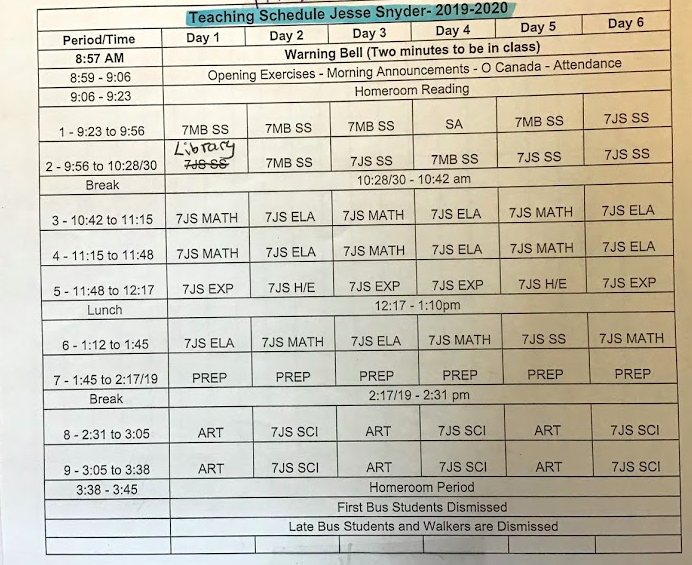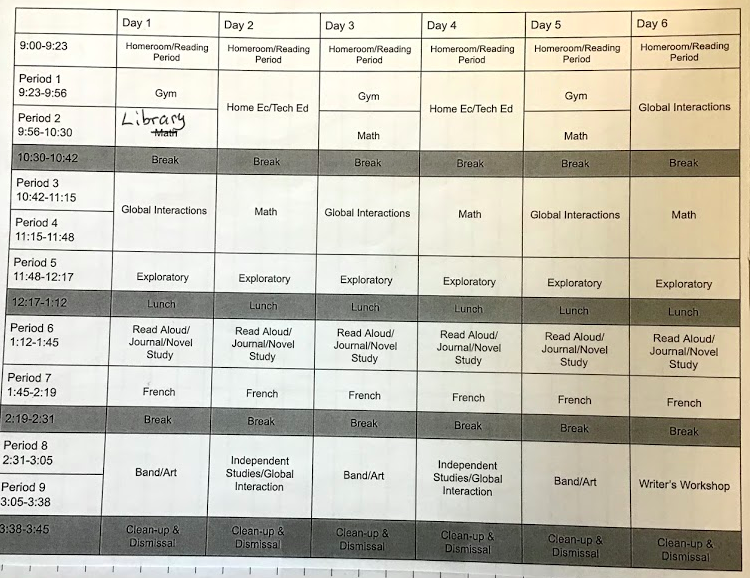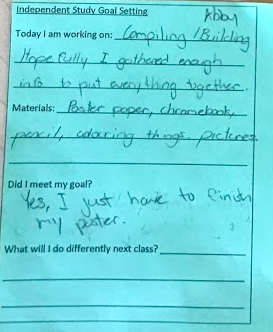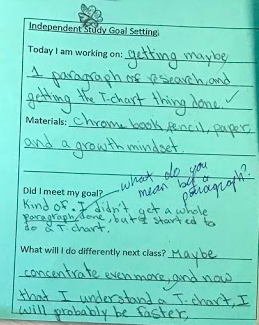I recently sat down with Jesse Snyder, Grade 7 teacher of the 4 cores at Clearspring Middle School. He has been exploring ways to not just integrate, but to infuse his Social Studies, Science, and ELA curriculum together. This has resulted in several changes to his teaching and to the scheduling, naming and nature of his classes.
Charmaine: You’ve been playing with Science and Social Studies integration…tell me about that.
Jesse: When I first started teaching, I found that there was never enough time to get into a topic in either Socials or Science with the traditional 30-45 minute blocks of time. I quickly started combining the time but my planning was still very much based on the curriculum clusters; I would do a Socials unit, then a Science unit and alternate like that. Last year I took a deeper look at the 2 curriculum documents and found that they can very nicely integrate into one course. There is so much carry-over. For example, in Science we do climate zones and in Socials we cover biomes. To really understand biomes, you need to learn about climate. Some of the units end up being more Science and some more Socials based, but how I progress with them, they mix in with each other. I start with a unit on government (which is all Socials), then I go into a unit called Our Beautiful Planet. It combines the Earth’s Crust and Ecosystems clusters, and I build in Socials topics like how to read a map, the hemispheres, knowing the continents and oceans, and kind of how that all fits together. In other places where it melds together is urbanization, migration, settlements (Socials), with Structures and Forces (Science): how are cities built to fit millions of people, but also what are the challenges of urban sprawl, the environmental impacts and all the push/pull factors? So that’s what I started last year. This year, I brought to the forefront of my mind that ELA is in everything, so I’m really trying to overlay that into the other curriculums. Currently the kids are doing an independent study project. On my timetable I intentionally put “Independent Study”, so this is a time that students explore some of the outcomes that I sometimes don’t get to in Socials and Science. This time around they are looking at human food production, preservation techniques and micro-organisms, etc. I gave them the outcomes I thought we wouldn’t be spending much time on and let them make meaning of them and learn about them in their own way. Through this we are looking at how do we research, how do we summarize, putting info in our own words, and how do we effectively showcase our knowledge. We use the question matrix to produce deeper questions that guide our learning.
Charmaine: Has this changed how you lay out your timetable for students?
Jesse: I had to get creative! This year it is tough because I had a lot of random 30 minute blocks instead of 60 minute blocks because of non-core subjects. Instead of Science and Socials on the schedule separately, we have Global Interactions in the morning. In the afternoons, on alternate days, is their Independent Study time, sometimes mixed with Global Interactions content from the morning. For the Independent Study time we have a timeline we build together, and they are starting to make goals for that time so they know their purpose and have a focus for that class.
Charmaine: So you don’t have specific ELA time in your schedule…
Jesse: No, it is integrated into Global Interactions and Independent Study, but I did keep the period right after lunch for time to do more specific ELA work. We wouldn’t necessarily write a short story in Global Interactions, so I made time in the day to do more specific ELA work, to allow kids to still have their time for creative and journal writings and Read Aloud. Depending on how things are going, I mix it up.
Charmaine: How has your thinking around teaching and learning shifted because of this change from a more traditional scheduling and executing of subjects to an integrated approach?
Jesse: With the traditional way I found you couldn’t get into something very deeply; 25 minutes would pass and students had to shift to something else suddenly, either into another subject or even a different classroom. The other thing I realized is that there is a huge hypocrisy in our education system. We need to have a set amount of time for each subject, according to the province, and yet the other directive is cross-curricular planning. In my mind, to do proper cross-curricular planning, you need to move away from strict time requirements and allow students to explore topics which combine a variety of outcomes. While I’m doing my best to honour time for both Science and Socials, it just doesn’t look like the neat, traditional timetable that we are used to. I do teach someone else’s class Socials, and it is interesting to compare and contrast how each way is going. It is exactly what I had started to feel in the past: the group I have once a day for 1 period is less productive and it is harder to really get into a topic.
Charmaine: Are there any other reasons why you wanted to move to integrated Socials and Science and ELA themes?
Jesse: I’m all about how we can develop inter-connected thinking. We teach the subjects separately and we expect and hope the students will make all the connections on their own but life doesn’t work that way; it is a huge smattering of things all at once. So, when the question comes up in Social Studies – does spelling and grammar count? I say, “Yes, of course it does! We are doing ELA right now, too. It counts everywhere.” Also the question, when working with graphs and tables in Socials, “Why are we doing Math in Social Studies?”, I can authentically respond, “Because it is everywhere, not just Period 1 and 2 on Day 1, 3 and 5!” I’m trying to help students see that the world is interconnected and life is more interesting when it isn’t all compartmentalized. This is the main motivation and belief I hold tight for making these changes, that are all in the test phase right now.
Charmaine: You mentioned a couple of benefits already…what are some others about this type of planning?
Jesse: It makes it a little easier, actually. You are planning for the same amount of content and I am doing a lot less direct lessons/quiet seat work and more projects which we take longer with, but the students are diving deeper into the outcomes. I find that some of the outcomes in Grade 7 may be 1 sentence, but they are complex concepts that take some picking apart to make sense of them. I’ve also been more intentional in my planning. With the traditional ELA course being dropped off of my timetable, I have to make sure that I am still hitting those outcomes and skills. I think it also makes their learning more authentic since a Speaking and Representing assignment is something they are working on and not artificially created to fill in that box on the report card. The other part I’m starting to include is reflection questions based on the 6Cs that Hanover is exploring. The hope is that at the end of each Independent Study project, students will take time to honestly and thoughtfully respond to these reflection questions.
Charmaine: Anything else?
Jesse: This year what’s brand new is the Independent Study time, and I am really enjoying it. A lot of them have said they like it too; the choice, the trust they are given to work independently and to interpret the outcome based on what they see as important in their lives and their learning. I give them the actual outcomes as they are written in the curriculum, we work with the language, and they make a proposal on what they what to explore. How they present their learning and understanding changes for each project, based on what ELA skills we are practicing: for example, one Independent Study project will have them create a story in the style of a children’s book, but might have their target audience as teenagers- so how do you present your information in a visual, fun, humourous way, while will showing a deep understanding and reaching your target audience?
Charmaine: This is your 6th year teaching….what impact have you noticed from your first year compared to this year because of these changes?
Jesse: I have had such a wide range of teaching experiences, that each year is wildly different. However, in general, teachers like to be in control. We want and need to know how each minute is planned or organized. However, by integrating curriculum and creating more thematic-based courses, especially with the Independent Study stuff, it forced me to move from that ‘sage on the stage’ to ‘guide on the side’. I’ve always wanted to move in that direction, but wasn’t always sure how. I had to become ok with not knowing the answer to everything and learning along with my students. It puts you in a different role. Sometimes it feels like I’m not a ‘real’ teacher, but I’m seeing good things- the questions and wonderings my students are bringing to their projects and our class discussions.
Charmaine: One issue that can come up when using less structured, more open-ended work like this is time management…
Jesse: Of course. And this was one my my major stresses about this shift. However, right now there is a range of success when it comes to this, so one thing I’m having them do is to set daily goals for Independent Study. I’m giving feedback with the expectation (hope?) that they will begin to internalize this habit of goal setting in order to use time productively. Like I said before, we make a timeline as a class to help, as well. Eventually I would like them to make their own timeline.
Charmaine: What are some wonderings you have about integrating Science and Social Studies into Global Interactions, and adding on Independent Study to this?
Jesse: Are they learning?!?! Lol! Because we go deeper with content I feel confident they are, more so than the traditional way but since my role has shifted from mostly direct teaching, it’s not always easy to get a sense of who is paying attention and who is off in their own world- so I have to be very conscious of taking time to check in with them individually quite frequently. How their talk is changing to more informed conversation is noticeable. I ask myself, “What don’t they know or understand and how can I best support them?” There are some skills and ideas that I need to better scaffold in the future, so I continue to learn what works best and how to better my teaching.
Charmaine: How about for next steps?
Jesse: I’m interested in integrating Math outcomes, too. That might be more of a challenge for me next year, but I’m already thinking about it now and toying with ideas. What projects or assignments can I add that bring out previous or current grade level math outcomes. I’m also spending time thinking about the “why” behind what my students are doing. I have a lot of assignments that I like, and they are good, but I don’t always know why they are good and why they work so well for my students’ learning- I want to figure out more of this.
This work all comes down to my students seeing themselves as learners, who they are, and how they fit into this world.




